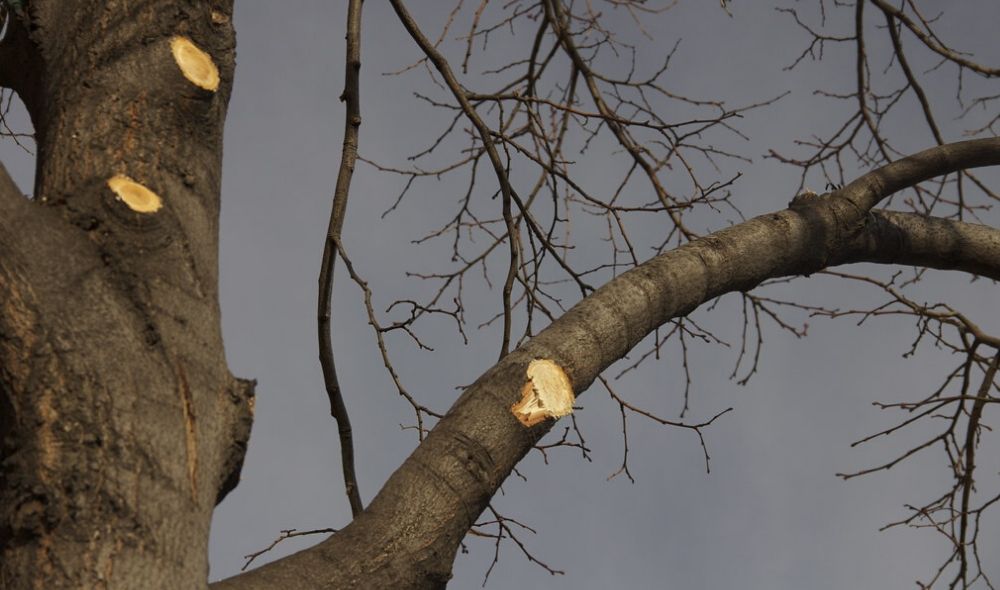
You may want to trim your tree for aesthetic reasons or safety reasons, but either way, keeping a tree trimmed is essential to its health. Topping and trimming are different techniques for managing tree growth.
What is Tree Topping?
Topping is cutting off the tops of mature trees, reducing the remaining top branches to stubs. This causes trees and their limbs to become weak and creates a potential risk. Removing the leafy crowns of trees, aesthetically makes the trees look bare and unnatural in appearance.
Other names for topping include:
- Heading
- Tipping
- Stubbing
- Dehorning
- Hat-racking
- Rounding over
Why People Top Their Trees
One of the main reasons a homeowner wants to have a tree on their property topped is to reduce the size of the tree because they believe it has become too large or that it might pose a future threat. Unfortunately, the topping method is not viable for reducing the tree’s height and does not lower potential risk — in fact, topping will increase risk in the long run.
Common reasons people choose to top trees is because they want to:
- Stop trees from interfering with electrical wires
- Prevent tall trees from coming down in a storm
- Shorten trees near their home to increase their view
It is plausible to take action and care for your trees because of these reasons, but tree topping is not the way you should try to accomplish these goals.
7 Reasons Why You Shouldn’t Top Your Trees
Topping causes permanent, irreparable damage and is a major threat to the tree’s health. There are many negative effects of tree topping, all of which can lead to tree death.
- Starvation – When you cut down the tops of trees, you’re cutting off the tree’s food-making ability. Removing too much of the leafy crown makes the tree unable to adequately provide for its roots. The roots are then prevented from growing and transporting nutrients and water to its leaves, thus starving the tree and reducing its lifespan.
- Stress – When a tree is put under stress, it will respond by growing shoots (also called suckers) near the surface of the old branches. Unlike normal branches that develop through overlapping wood tissues, these new shoots are weakly attached to only the outermost layers of the parent branches and are prone to breaking. Shoots usually grow back to the original height of the tree, which defeats the purpose of topping in the first place.
- Sunburn – The tree’s natural canopy of leaves protects its bark from direct sunlight. When the canopy is removed, the bark is suddenly exposed to high levels of light and heat. Tissues beneath the bark become sunburned which can lead to cankers, bark splitting, and branch death.
- Weak limbs – The tree is forced to quickly grow new limbs from the larger, cut branch. The younger limbs are weakly attached to the parent branch and often cannot withstand storms. If the original goal was to reduce risk by reducing the tree’s height, the risk of limb failure actually increases from topping.
- Insects – The large open wounds caused by tree topping have difficulty closing, compromising the tree’s natural defense system. The tree releases chemical signals, which some insects are attracted to. The tree may not have the energy to chemically defend the wounds against insect invasion.
- Disease/decay – The large stubs remaining after topping rarely close or heal properly, making them vulnerable to disease. Open wounds invite the spread of decay fungi. If decay is already present in the limb, cutting it will only speed up the decay process.
- Ugliness – The natural branching structure of trees form dense balls of foliage. Topping leaves ugly stubs and destroys the natural form of a tree, making it appear disfigured and mutilated. A topped tree can never fully regain its natural form.
The Healthy Alternative to Tree Topping – Trimming
Topping only provides a temporary solution to oversized trees and can be a costly mistake in the long run. The tree will either need extra care to stay alive or will eventually need to be removed. Trimming, on the other hand, is the proper way to care for your tree and maintain its health. Trimming is when specific branches are removed to benefit the entire tree. Trimming will keep your yard looking its best and allow your landscape to thrive.
Benefits of Tree Trimming
Trimming is often referred to as pruning when it is related to the tree’s health, such as removing branches that are diseased, infested, or interfering with healthy growth.
The benefits of trimming include:
- Healthier trees – Trimming overgrowth strengthens trees and increases their likelihood of survival
- Hazard prevention – Properly removing limbs and branches reduces the risk of them falling and causing danger to your family and destruction to your home and property
- Cheaper cost – Avoiding potential hazards to people and your property will, in turn, save you money
- Early detection of tree issues – Regularly trimming trees can help identify any issues or diseases that will need to be treated, the sooner they are found the better
- Increased sun exposure – Trimming trees increases sun exposure and air circulation, helping improve tree and landscape health
- Higher property value – Attractive, healthy trees on your property are desirable to homeowners and will increase the value of your home if you are looking to sell
Tree Trimming St. Louis, MO
Our tree experts understand the damage caused by tree topping and will not subject your trees to the unhealthy technique. The certified arborists at Omni Tree Service will properly care for your trees by trimming and pruning them. Contact us in St. Louis at 636-324-2101 to schedule an appointment.






